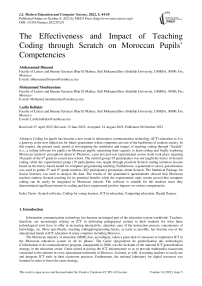The Effectiveness and Impact of Teaching Coding through Scratch on Moroccan Pupils’ Competencies
Автор: Abdessamad Binaoui, Mohammed Moubtassime, Latifa Belfakir
Журнал: International Journal of Modern Education and Computer Science @ijmecs
Статья в выпуске: 5 vol.14, 2022 года.
Бесплатный доступ
Coding for pupils has become a new trend in information communication technology (ICT) education as it is a gateway to the new digital era for future generations where computers are one of the backbones of modern society. In this respect, the present study aimed at investigating the usefulness and impact of teaching coding through “Scratch” (i.e., a coding software for pupils) on Moroccan pupils, measuring their capacity to learn coding and finally exploring Moroccan teachers’ perceptions about it. Therefore, a pre-test post-test experimental course study took place targeting 38 pupils of the 6th grade in a rural area school. The control group (19 participants) was not taught the basics of Scratch coding while the experimental group (19 participants) was taught through practical Scratch coding initiation lessons based on the theory-based model for computer programming teaching. Furthermore, a quantitative survey questionnaire was used to gather 5th and 6th grade teachers (202 participants) perceptions about Scratch. The Statistical Package for Social Sciences was used to analyze the data. The results of the quantitative questionnaire showed that Moroccan teachers endorse Scratch teaching for its potential benefits while the experimental study results proved that computer coding can be easily be integrated in Moroccan schools. The software is suitable for the students since they demonstrated significant interest in coding and have experienced positive impacts on various competencies.
Scratch software, Coding for young learners, ICT in education, Computing education, Digital fluency
Короткий адрес: https://sciup.org/15019088
IDR: 15019088 | DOI: 10.5815/ijmecs.2022.05.05
Список литературы The Effectiveness and Impact of Teaching Coding through Scratch on Moroccan Pupils’ Competencies
- J. Maloney, M. Resnickl, N. Rusk, B. Silverman, and E. Eastmond, “The Scratch Programming Language and Environment,” ACM Transactions on Computing Education (TOCE), Nov. 2010, doi: 10.1145/1868358.1868363.
- M. Resnick et al., “Scratch: programming for all,” Commun. ACM, vol. 52, no. 11, pp. 60–67, Nov. 2009, doi: 10.1145/1592761.1592779
- J. Maloney, L. Burd, Y. Kafai, N. Rusk, B. Silverman, and M. Resnick, “Scratch: a sneak preview [education],” in Proceedings. Second International Conference on Creating, Connecting and Collaborating through Computing, 2004., Jan. 2004, pp. 104–109. doi:10.1109/C5.2004.1314376.
- M. Prensky, “Digital Natives, Digital Immigrants Part 1,” On the Horizon, vol. 9, pp. 1–6, Sep. 2001, doi: 10.1108/10748120110424816.
- M. Takhlouicht, D. Amezian, N. Essassi, and Y. Benhnayn, “Teachers’ guide.” Moroccan ministry of education, 2020.
- B. Xie et al., “A theory of instruction for introductory programming skills,” Computer Science Education, vol. 29, no. 2–3, pp. 205–253, Jul. 2019, doi: 10.1080/08993408.2019.1565235.
- S.-H. Farooqi, Khan, A. Fatimah, M. Ghulam, and M. Seemab, “Effectiveness of an Educational Software System (Desire2Learn) in Teaching English Grammar – AWEJ.” https://awej.org/effectiveness-of-an-educational-software-system-desire2learn-in-teaching-english-grammar/.
- C.-J. Chung and L. Shamir, Introducing Machine Learning with Scratch and Robots as a Pilot Program for K-12 Computer Science Education. 2021.
- D. Franklin et al., “Assessment of computer science learning in a scratch-based outreach program,” in Proceeding of the 44th ACM technical symposium on Computer science education, New York, NY, USA, Mar. 2013, pp. 371–376. doi: 10.1145/2445196.2445304.
- E. Yukselturk and S. Altiok, “An investigation of the effects of programming with Scratch on the preservice IT teachers’ self-efficacy perceptions and attitudes towards computer programming: Programming with Scratch,” British Journal of Educational Technology, vol. 48, Apr. 2016, doi: 10.1111/bjet.12453.
- E. Lee and L. Youngjun, “The Effects of Scratch Based Programming Education on Middle School Students’ Flow Level and Programming Achievement.” http://www.kci.go.kr/kciportal/landing/article.kci?arti_id=ART001272799
- P. Gruenbaum, “Undergraduates Teach Game Programming Using Scratch,” Computer, 2014, doi: 10.1109/MC.2014.49.
- J. Bagulaya-Abogaa, “Beginners Learned Competencies in Scratch 2.0 Programming,” International Journal of Computer Applications, vol. 172, pp. 48–51, Aug. 2017, doi:10.5120/ijca2017915137.
- N. Dabbagh, “Pedagogical Models for E-Learning: A Theory-Based Design Framework,” Int J Technol Teach Learn, vol. 1, Jan. 2005.
- I. S. McGowan, Towards a Theory-Based Design Framework for an Effective E-Learning Computer Programming Course. International Association for the Development of the Information Society, 2016. Available: https://eric.ed.gov/?id=ED571406
- I. Etikan, “Comparison of Convenience Sampling and Purposive Sampling,” American Journal of Theoretical and Applied Statistics, vol. 5, p. 1, Jan. 2016, doi:10.11648/j.ajtas.20160501.11.
- X. Weng, Z. Cui, O.-L. Ng, M. S. Y. Jong, and T. K. F. Chiu, “Characterizing Students’ 4C Skills Development During Problem-based Digital Making,” Journal of Science Education and Technology, 2022, doi: 10.1007/s10956-022-09961-4.
- L. Zhao, X. Liu, C. Wang, and Y.-S. Su, “Effect of different mind mapping approaches on primary school students’ computational thinking skills during visual programming learning,” Computers and Education, vol. 181, 2022, doi: 10.1016/j.compedu.2022.104445.
- A. Theodoropoulos and G. Lepouras, “Game Design, Gender and Personalities in Programming Education,” Frontiers in Computer Science, vol. 4, 2022, doi:10.3389/fcomp.2022.824995.
- J. Bender, B. Zhao, A. Dziena, and G. Kaiser, “Learning computational thinking efficiently,” 2022, pp. 66–75. doi: 10.1145/3511861.3511869.
- H. Suriyaarachchi, P. Denny, J. P. F. Cortés, C. Weerasinghe, and S. Nanayakkara, “Primary school students programming with real-time environmental sensor data,” 2022, pp. 85–94. doi: 10.1145/3511861.3511871.
- H. Suriyaarachchi, P. Denny, and S. Nanayakkara, “Scratch and Sense: Using Real-Time Sensor Data to Motivate Students Learning Scratch,” 2022, vol. 1, pp. 983–989. doi: 10.1145/3478431.3499316.
- I. Ouahbi, H. Darhmaoui, and F. Kaddari, “Visual Block-based Programming for ICT Training of Prospective Teachers in Morocco,” International Journal of Modern Education and Computer Science, vol. 14, no. 1, pp. 56–64, 2022.
- A. Kesler, T. Shamir-Inbal, and I. Blau, “Active Learning by Visual Programming: Pedagogical Perspectives of Instructivist and Constructivist Code Teachers and Their Implications on Actual Teaching Strategies and Students’ Programming Artifacts,” Journal of Educational Computing Research, vol. 60, no. 1, pp. 28–55, 2022, doi: 10.1177/07356331211017793.
- K.-D. Boom, M. Bower, J. Siemon, and A. Arguel, “Relationships between computational thinking and the quality of computer programs,” Education and Information Technologies, 2022, doi: 10.1007/s10639-022-10921-z.


